Wild cat to countryside
Felis Silvestris
Felis silvestris, the wild cat, is a project aimed at reintroducing this species into the Czech countryside. The cat has been a part of the Czech landscape for centuries, and is still present today. The project has been made possible by the acquisition of more than 250 hectares of land on which it will be carried out.
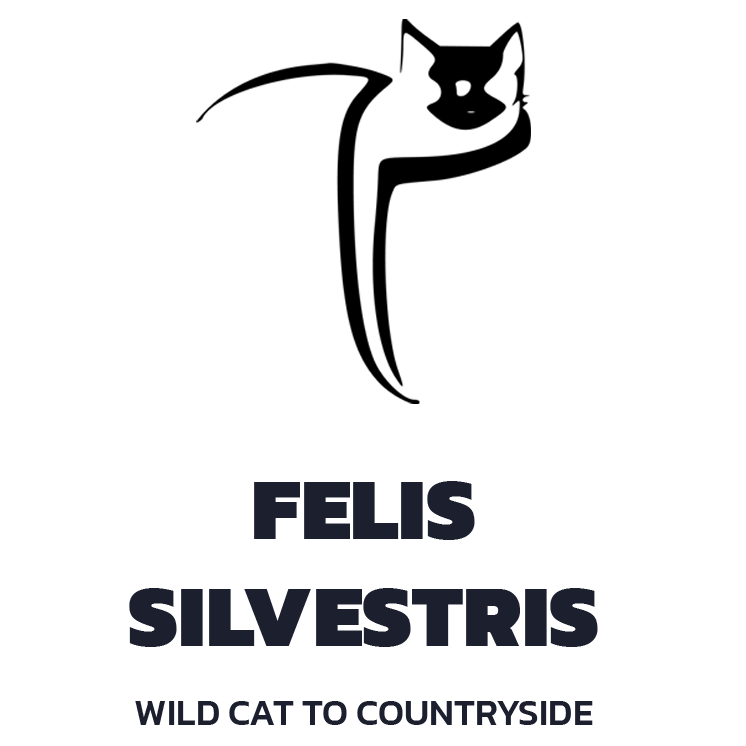
In the first phase of the project, the existing population of cats in the vicinity of towns and villages will be monitored, and in more remote areas. Once the situation has been documented, the second phase will see the active promotion of cat populations in areas further away from human habitation, and the development of a methodology for the sustainable presence of wild cats. In the final phase of the project, cats will be released into the wild and their population will be actively monitored, supported and managed.
The motivation for the return of the cat to the Czech countryside is multifaceted. Firstly, there is a desire to gain a deeper understanding of their social behavior and the dynamics of their relationships, which are little-researched but nonetheless fascinating. Cats are intelligent creatures, and their interactions with each other are a combination of unique elements with surprising similarities to the dynamics of social relationships in human society. Secondly, the cat is simply a beautiful animal.
The Felis silvestris project therefore represents a unique opportunity to study an important species in its natural habitat, and to contribute to its conservation.
Observational Campaign on the Feral Cat Population in the Drahanská Vrchovina Region, Czech Republic: Project Felis Silvestris, May 2023
For eleven months from June 2022, the largest ever observation campaign focused on the cat population in the landscape in the Czech Republic took place in the Drahanská vrchovina region. The privately funded Felis Silvestris project completed its first phase in May 2023.
Programme results - baseline data
- 325 days in the field (from 16 June 2022 to 7 May 2023)
- 50 917 observation hours (2122 days)
- 55 observation sites over 25 km2
- 6000+ partial records collected
The Felis Silvestris program is funded by a private investment fund. The return on funds invested in software development has been satisfactory, and the code and methodologies have been successfully applied to commercial projects. Costs have not exceeded the budget and unit costs have been reduced during the project.
Programme results - methodology
- We validated the observation technique using cameras in cotboxes, bait and attractant.
- We developed a sustainable software system to collect, evaluate and retain observation data.
- We have developed theoretical models, calibration methodologies and software tools to quantify the abundance of cats and other observed animals (calculate density maps) with good accuracy.
- We have created a prototype of image classification using AI and, beyond the original intention, a temperature map of the area has been created (photo traps provide temperature data).
The methodology proposed based on previous observing campaigns by other teams has been technically proven to work. It is very selective to animal species - while cats are not afraid of the boxes and will climb inside without much hesitation, foxes are already significantly more wary. The badger could not be lured into the crate at all and was only captured by a camera placed in a tree.
Results of the programme - ethological and ecological conclusions
- Domestic cat populations predominate, their territories overlap.
- The occurrence of cats in the field outside the development exists, but is rather sporadic, reduced to the edges of forests.
- Three individuals (males) have been observed at three separate locations more than 2 km from the village, and it is reasonable to theorise that they could be male feral cats.
- Outside the development, the sightings best capture the sharp territorial pattern of non-overlapping areas where cats compete for territory with foxes and badgers. The landscape is thus divided into 'cells' of about 2 km2 each, each occupied by one individual (or more in the case of badgers) of a given animal species. All three species (fox, badger, cat) are represented approximately equally.
The final numbers, the density map of the target area and the final form of the behavioural model of the cat in the landscape, will only be available after the last 200 GB of data have been processed. However, the findings will not be significantly different from the last interim results - the winter and early spring months have not yielded many new observations.
A few kittens were released into the field as part of the programme. The experiment did not yield any significant results, the kittens were only observed for a few days, after which they moved away from the site. A follow-up observation a few weeks later at a different location is considered.
One of the objectives of the Felis Silvestris project is to find out whether and how the wild cat could be successfully introduced into the landscape. Phase 1 gives an answer roughly along the lines that it is possible, there are sites in the target area that are sufficiently distant from settlements, yet sufficiently fertile, with a suitable climatic profile during the year. However, a population introduced in this way would have to compete with foxes and badgers in an already occupied ecological niche if we did not remove them from the site earlier. Further research is needed to obtain a more accurate behavioural model of the cat in the landscape to model feral cat introductions more reliably and to suggest in more detail a possible course of action.
Programme results - impact on local communities
- The project has been communicated locally in a targeted way on several occasions (internet discussion groups, web, social networks). The response was generally positive.
- The reception of the physical devices was completely smooth, with no loss or damage to any of the devices. On the contrary, when the cotoboxes were found accidentally, people repaired the devices several times.
- In several chance encounters with people in the field, we noted interest in the issue and surprisingly very good awareness of the feral cat.
The main aim of this part of the programme was not to make enemies, which was very well achieved. Local communities and interest groups had no problem with the project, the observation techniques used were unobtrusive and mostly below the threshold of public perception.
Conclusion, next steps
- The methodology used will no longer yield major new insights. A meaningful continuation of the programme requires a change and extension of the methodology, new technical resources and an expanded system solution.
- For Phase 2, an intensive observation campaign over a small area, focusing on the ethology of the domestic cat population, seems most appropriate.
- During this phase, we will attempt to add new technical means and methods of cat monitoring to the existing ones.
- No specific design of new technical means is available after Phase 1.
In other words, the field camera boxes as we have been using them will probably only provide refinement and verification of the numbers already obtained. We need to monitor the movements of individuals, ideally in real time, and at the same time in a way that we don't have to capture them. We have no design, even preliminary, of a technical solution for a system that would provide this at present.
In the second phase of the project, we will use existing equipment, focus it on a selected area of about 2 km2 and use the higher resolution observations to refine a behavioural model of the cat in the landscape.
Finally, we would like to thank all residents of Runářov, Konice, Brodek u Konice and Lhotka u Brodek, all private and public landowners and all visitors to the area for their understanding and kind welcome. Thanks also to all the volunteers for their helpful thoughts and helping hands.
Primary data, software, results and documentation are available to serious interested parties upon request (info@avirtu.net).
March 2023
For almost a year now, an observation campaign has been underway in the Konice area, focusing on the population of cats living in the wild and near human dwellings. I would like to take this opportunity to thank the residents of Skřípov, Runářov, Konice and other villages in the area for their kindness and helpfulness.
In one year of observation, we did not lose a single photo trap at any of the almost sixty sites. What's more, during the winter months, when some traps suffered from inclement weather, someone unknown, presumably from the surrounding area, treated and adjusted them so that they would continue to function.
It's nice to know that we hit a place not only interesting for cats, but also rich in friendly people. Thank you!
February 2023
The observation campaign continues this year. This time, however, we were not visited by a feral or domestic cat, but by a completely different animal.
Badgers are known for their distinctive appearance, which includes a robust body, short legs and a flattened head with sharp teeth and claws. They have a thick coat that ranges in colour from grey-brown to black and, depending on the species, usually weigh between 5 and 15 kg.
Our badger was walking in an old orchard, the camera was set up in a tree by the well. Judging by the beaten track, it is a frequent visitor here.
Badgers are primarily nocturnal animals and are known for their burrowing abilities. They build complex systems of underground burrows that can contain several entrances, tunnels and sleeping chambers. Badgers are omnivorous and their diet consists of a variety of foods including insects, small mammals, fruits and roots.
In the Czech Republic, badgers are protected by law and are considered an important part of the wildlife. They are also a popular subject of Czech folklore and are often portrayed as clever and resourceful animals.
Not far from this location is another site that is literally riddled with badger dens. Although the Felis Silvestris project is focused on mapping the cat population, we will definitely install cameras there in the near future. It's such a cute animal after all 🙂
October 2022
The Felis Silvestris programme has already completed almost five months of field measurements. Let me remind you that we use photo traps, wooden boxes with scent attractants and software to monitor the behaviour of wild cats.
Felis silvestris is currently probably the largest observation campaign of this species in the Czech Republic. The target area is now 23 square kilometres, with 9-10 observation sites running in parallel. We have already mapped, if not all, then at least most of the free-ranging individuals in this area; there are nine of them. The first controlled introduction of new individuals has taken place, and in connection with this we have gone further in the measurement methodology itself. One of the most interesting things in the last two weeks or so has been the shift in our understanding of cat behaviour in the wild.
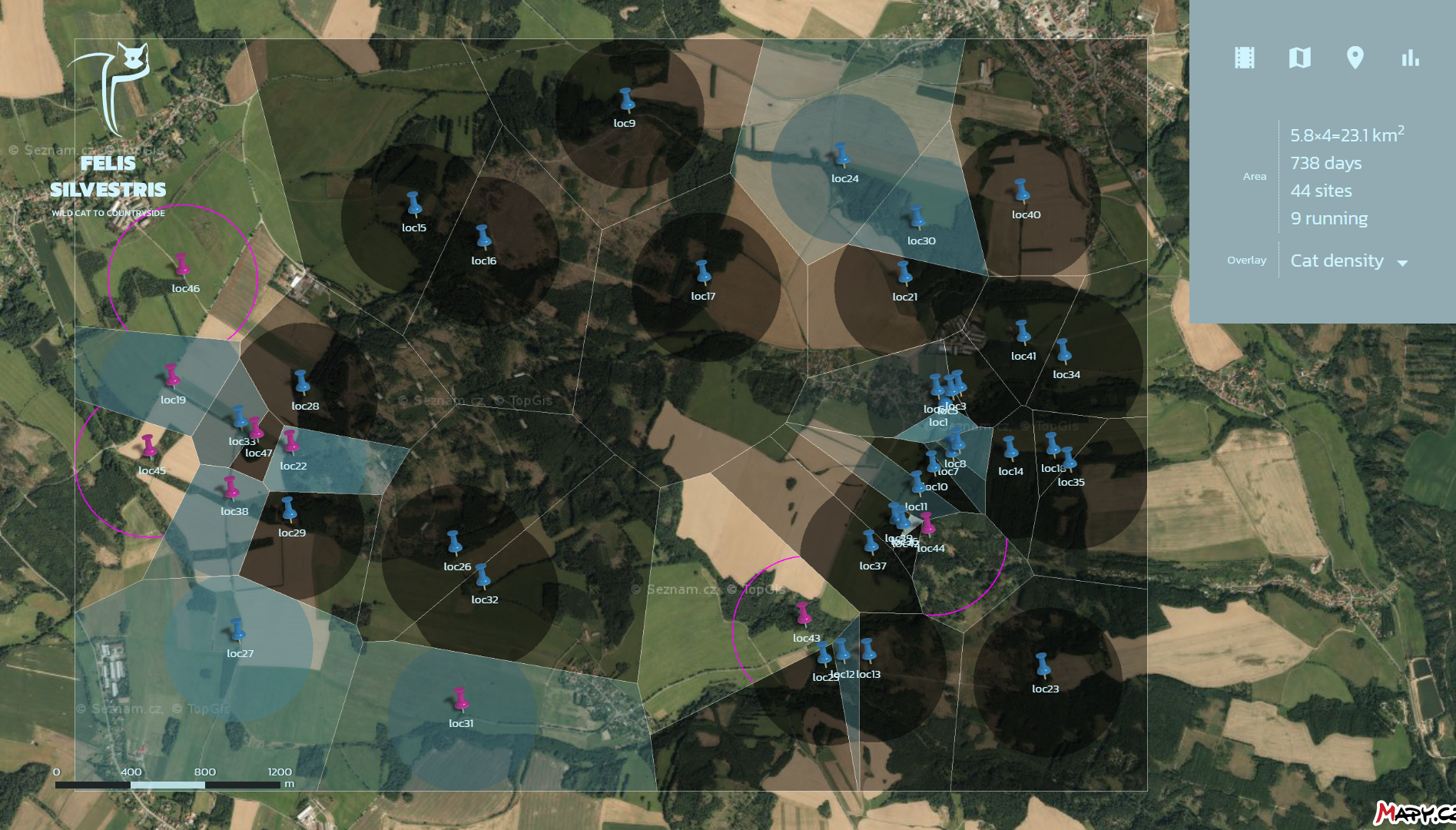
Over the last two months, a seemingly simple question that has come to the forefront from the data - why are there cats in some locations in the target area and none at all in others? That is, none of the proposed factors correlate with cat density. Mouse density doesn't correlate with it, temperature doesn't correlate with it, even AI classifiers of aerial imagery of particular areas show no hidden patterns.
It's only in the last two weeks that we seem to be on the right track. We can answer that question if we express the movement of a cat across the landscape using a behavioural model that is still very simple, but no longer "physical".
So far, all the calculations in the project have used a deliberately trivial model, based on the assumption that each cat has a permanently defined territory that it will traverse once every few days at most (and in doing so, encounter a photo trap). Such a model then allows the times of individual measurements, or the mean time between cat visits to a given site, to be converted into a density of individuals per square kilometre. Such a model does this well, but it does not provide any answer to the question of why cats are present in some areas and not in others.
If we start from the ecological theorem that there is no unoccupied ecological niche in the steady state, then wherever a cat doesn't freeze and there is food, there should be a cat. The project not only measures the density of cats, it simultaneously counts the density of mice, hedgehogs, foxes and all the other curious critters that poke their heads into our observation boxes, so we know that there are large areas in the landscape where mice abound but no cats.
The results of the simulations we've been producing over the last two weeks are consistent with the cause not being in the landscape at all, but in the movement dynamics of the cats themselves. That is, the areas without individuals are not caused by any landscape factor, but by how the cats themselves function.
In the simulations, we used a behavioral model of random walk with history. A simulated cat moves along a 2D grid, with few paths to neighbors to choose from at each node. It chooses from these paths by weighted random selection, with the weights of each choice based on the history of previous visits to the neighboring node to which the path leads. The history can be evaluated arbitrarily, it is a free parameter of the model (so it is actually a family of models). In a simple yet perfectly workable version, we add weight (and thus increase the probability of its selection) to those neighbors that have been visited by the cat in the last ten days, and decrease it to those that have been visited by another cat in the last ten days. Nodes that have not yet been visited have a default weight, which is another parameter of the model.

Our observations allow us to calibrate the model with a realistic value of the average speed of a cat across the landscape, and thus finally obtain from the simulation a map of the density of cats in a real area. That's the second image where you see sort of colored puffs. The distance of the grid points in the picture is 10 meters, each color corresponds to one cat. There are nine cats in total, their starting position is random. The simulation lasts 365 days of virtual time, so each colored point corresponds to a place corresponding to 100 square meters visited by a cat in one year.
Note that much of the area is not visited by cats at all. It's about half the area - which corresponds well to the real field results. Importantly, except for cat speed, we got the result from just making assumptions about the principles of cat behavior. This is very interesting. A more detailed analysis of the simulations and comparison with real data is definitely a topic worth pursuing further.
The Felis Silvestris program is funded entirely by private investors. Many thanks to all our collaborators.
September 2022
Tracking cats is quite fun - dragging wooden crates through the forest, rolling in pine needles, while downloading data from photo traps... It's such a nice summer activity combining the pleasant with the useful.
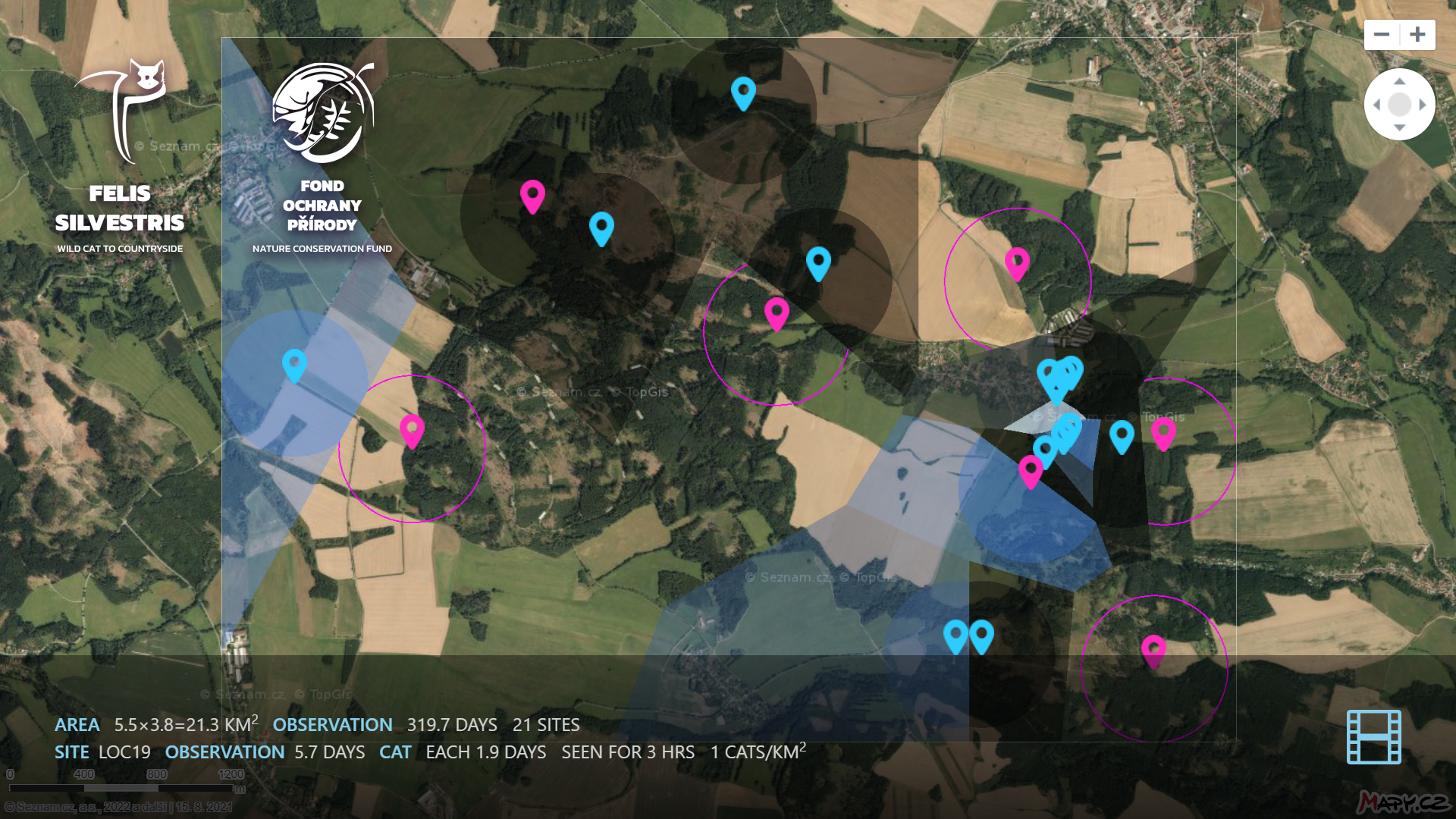
We collected data from 11 square kilometers in three months. We have a complete workflow from fieldwork to presentation of model results. The findings are still preliminary, we will be collecting more observational data over the next month or two and verifying that the models are working consistently.
A few highlights:
It is now coming out that there are 12 free-roaming cats living in the 20 km2 target area. This is a result in good agreement with the original estimates of 0.3-3 cats/km2, which were based on the fertility of the landscape (how many cats eat mice, how many mice eat grain, how much grain is harvested per hectare).
The density map shows areas where cats are virtually absent. But mice are massively present, so we have several gigabytes of video of the cheerful rodents. How does it all come together? Apparently there's an unknown species-selective factor working against cats.
We've seen foxes in two locations so far. They don't seem to get along with cats - where there are foxes, there are no cats, and vice versa.
Cats stick to their habits. If they visit the cat box at 2am one day, the next visit will also be at 2am. The cats are most active between eight and ten in the evening, then they have a lull (or are engaged in something other than visiting the cotoboxes) followed by a high peak between two and three in the morning. What synchronizes this cycle? One might guess by the sun; then it would vary measurably with the time of year. We need more data.
And finally, there's an individual in the records that meets all the external characteristics of a wildcat. Unfortunately, it is virtually impossible to decide without DNA analysis, and for that we would need to capture the animal. The presence of a feral cat in the target area would be an unexpected surprise.
July 2022
The Felis silvestris programme has its first data. The installed catboxes are sought after by cats, the technology works perfectly. Within the next three months we should have the population mapped throughout the target area. The long period of conceptual preparations has paid off - the programme has got off to a better start than expected.
The target area is over 100 square kilometres. We are mapping the population by placing catboxes and tracking their attendance. A catbox is placed in one location for two weeks, after which it is moved. By late September/early October, we should have a map of the areal density of cats and with it an answer to the basic question - is there an unoccupied niche in potentially favorable locations or is the entire area already occupied by domestic cats?
June 2022
In June 2022, the first catbox was installed in the target area. The device is designed to monitor the existing population of cats. During the first months, we will standardize the methodology for monitoring and collecting field data.
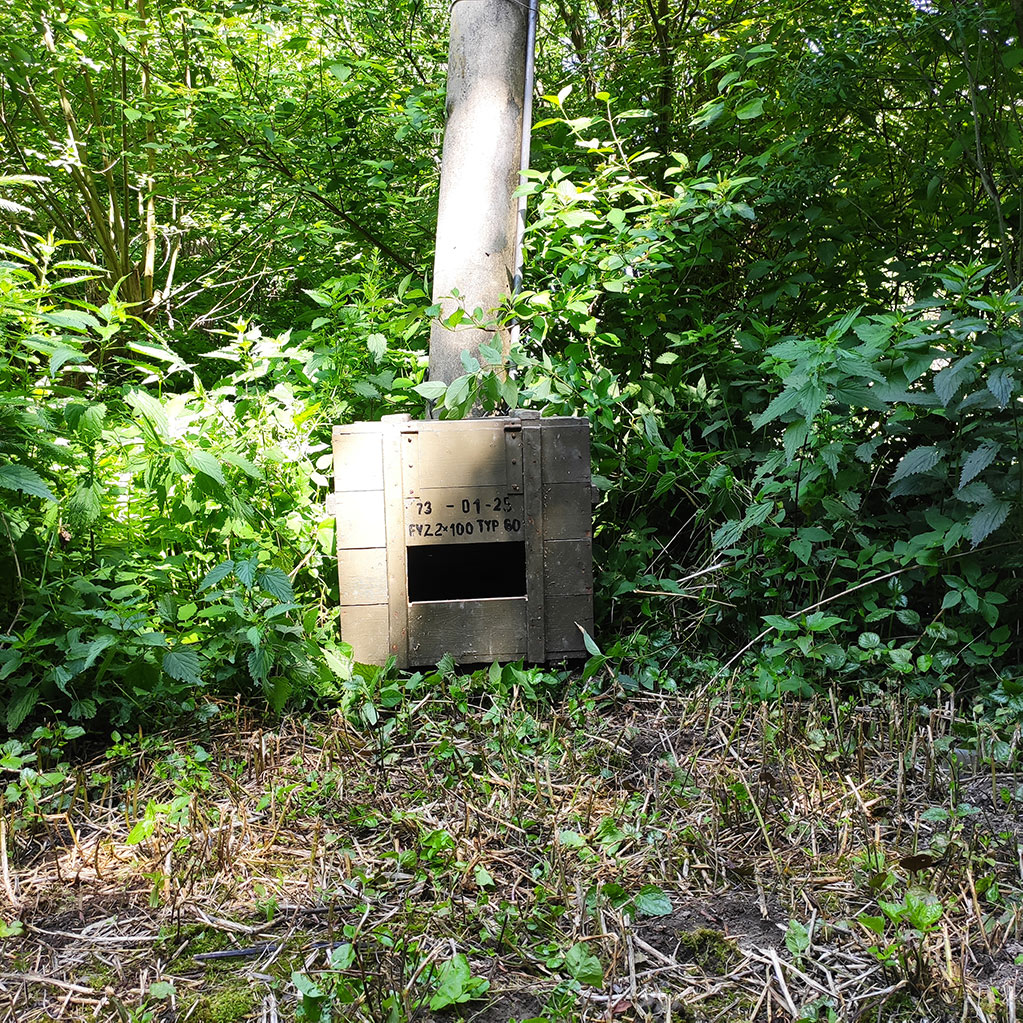
The questions we want to answer: Is the catbox properly designed? Are the cats attracted to it? Is the device for monitoring functional? Does it provide quantitatively usable data? Can the technology used distinguish between individuals? What data can we get about the social behavior of cats? How can the methodology be further improved?
The catbox will be installed permanently in the vicinity, so that we can simultaneously monitor the populations of cats living near people and those in the deep forest.
SWOT Analysis
Strengths
- The project has a clear and well-defined purpose.
- It has the support of a reputable organisation (Fond ochrany přírody).
- It has a clear plan of action, with different phases defined.
- There is a clear motivation for the project (to help preserve biodiversity and to study the social behaviour of cats).
Weaknesses
- The project may be expensive to implement.
- There is a risk that the cats released into the wild may not be able to survive and thrive.
- There may be public opposition to the project, due to concerns about the impact of feral cats on the environment.
Opportunities
- The project could help to improve the public image of cats.
- The project could help to raise awareness of the importance of biodiversity.
- The project could be used as a model for other reintroduction programmes.
Threats
- The project could fail, due to a lack of funding or public support.
- The released cats could pose a threat to native wildlife.
- The project could have a negative impact on the local environment.
Q&A
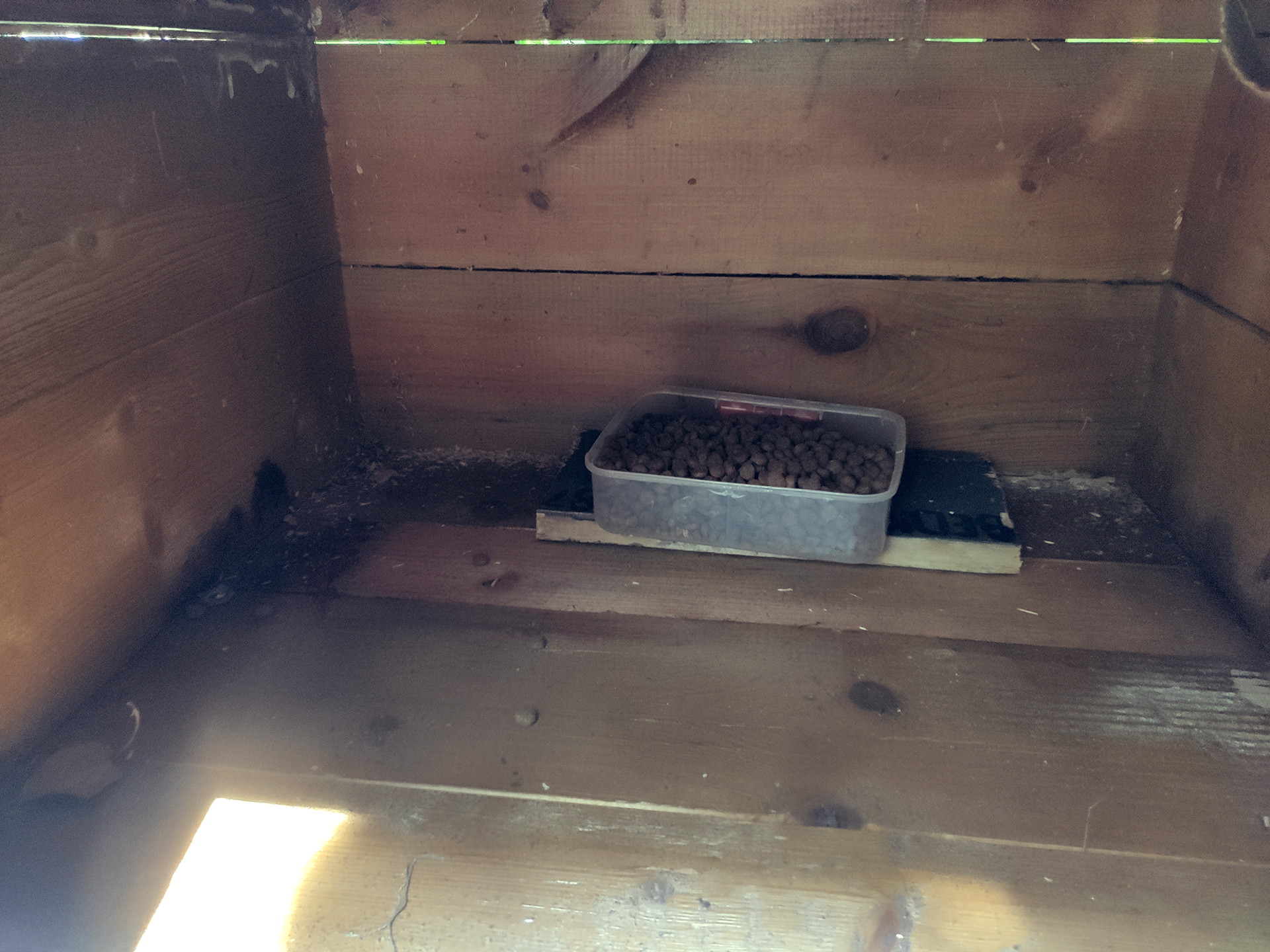
What is a catbox?
A cat box is a device designed to monitor and manage the cat population. Technically, it is a wooden box adapted to be sought out by cats - a quiet, dry, leeward place, with occasional food supplementation and treatment with a special insecticide. The facility is equipped with a tracking device that allows us to monitor individuals and assess their behaviour and health.
What type of personality does the MBTI think will most support the Felis Silvestris project?
The most supportive personality type for the Felis Silvestris project would be an ENFJ. ENFJs are natural leaders, and are often motivated by a desire to help others. They are good at mobilizing people and resources, and are often very passionate about their causes. They would be ideal for promoting the project to the public and raising awareness of the importance of biodiversity.
What type of personality does the MBTI think will least support the Felis Silvestris project?
Introverted Sensing (IS) personality types will likely be the least supportive of the Felis Silvestris project. These personality types tend to be more traditional and practical, and may not be interested in the project's goals of reintroducing a wild animal into the Czech countryside. They may also be skeptical of the project's chances of success, and may not want to support something that they see as a long shot.
History of project
2022
- The concept for the project is created, with goals and priorities set.
- Funding for the project is secured from the Fond ochrany přírody.
- An agreement is reached with landowners for the use of their land for the project.
- The first catbox was installed in the target area.
- We collect the first field data, validate the concept, methodology and technological equipment.
- We created a plan for the first campaign mapping the target area.
- Based on the first results, investors released additional money to buy equipment.
- We installed new catboxes and tracking equipment.

Philosophy + Inspiration = Concept
The Felis silvestris project is inspired by the belief that humans and cats can coexist in harmony. The project seeks to reintroduce the wild cat into the Czech countryside, with the hope that they will play a role in preserving biodiversity. The project is also motivated by the desire to study the social behavior of cats, and to learn more about their unique relationship with humans.
The project is made possible by the latest advances in technology, which allow for the monitoring of cat populations in a way that was not previously possible. The use of catboxes is a key part of the project, as they allow for the collection of data on the behavior of individual cats. This data will be used to study the social dynamics of cat populations, and to develop a methodology for the sustainable presence of wild cats in the Czech countryside.

Engage your cat in the project
The Felis silvestris project is looking for healthy, not-too-much-socialized cats to take part in the project. If you have a cat that fits this description, you can contact the project team to arrange for your cat to be released into the target area. The cats will be monitored as part of the project, in order to assess the impact of the reintroduction on the local ecosystem.
Contacts
Contributors
Markéta Verbiková (breeder)
Pavla Verbiková (a willing catcatcher)
Jaroslav Bartošek (expert consultation in the field of measuring hardware and sensors)
Tomáš Ďurovec (image analysis, programming)
Credits
Burhan Joukhadar (code)
Govert van Drimmelen (code)
The project is financed by the Nature Conservation Fund.
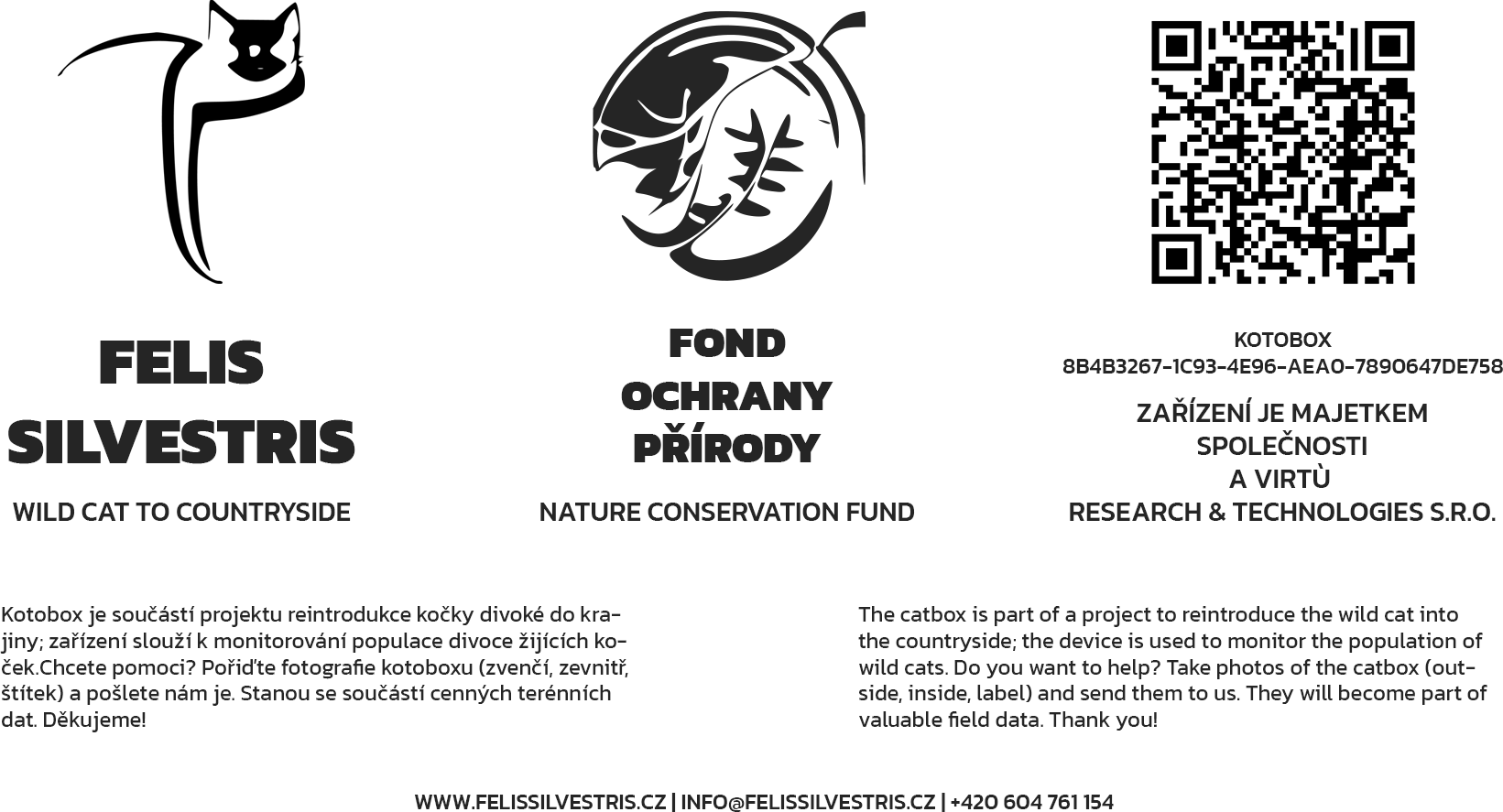
©2022 Fond ochrany přírody
